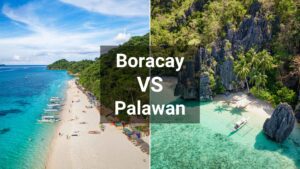17 Best Places to Visit in Philippines
Embarking on a journey to the Philippines opens a world of unparalleled beauty, where emerald rice terraces blend seamlessly with turquoise seas, and the warmth of its people rivals that of its tropical climate. This archipelago, made up of over 7,000 islands, offers a diverse tapestry of experiences that can captivate any traveler’s heart. From the bustling streets of Manila to the serene shores of Palawan, each destination presents a unique adventure waiting to be discovered. In this article, we explore the 17 best places to visit in the Philippines, guiding you through the hidden gems and celebrated wonders that make this country a must-visit on any traveler’s list. Whether you’re a beach lover, a history enthusiast, or someone in search of tranquility, the Philippines has something special in store for you.
1. El Nido, Palawan - breathtaking limestone cliffs and turquoise waters.
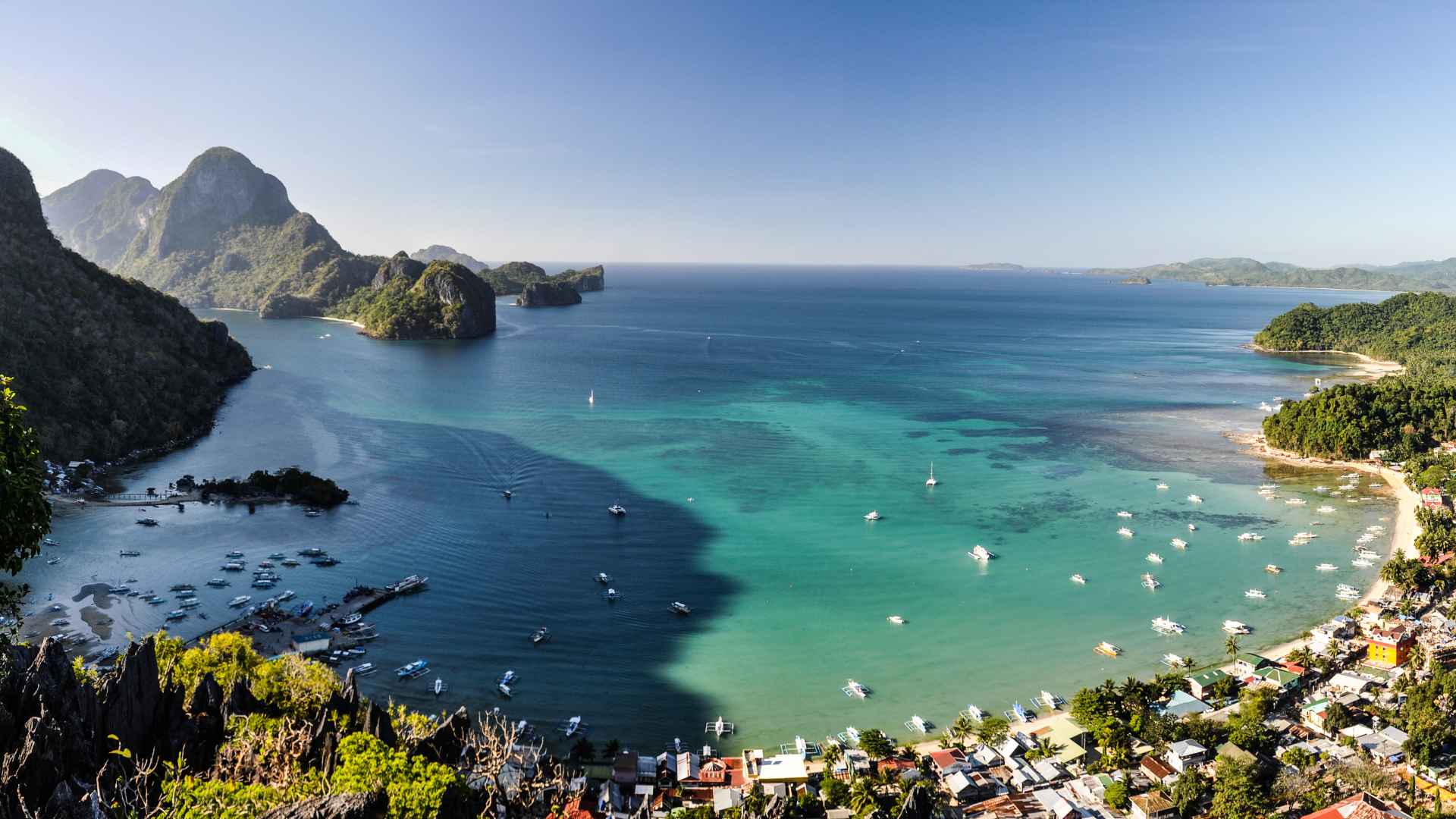
El Nido is a captivating destination that combines the natural beauty of the Philippines with a rich array of activities and cultural experiences:
What is it: El Nido is a coastal town, celebrated for its stunning geography, consisting of limestone cliffs, white sand beaches, and a plethora of diverse marine ecosystems. This area is not just a beach paradise but a showcase of the Philippines’ natural wonders, making it a focal point for conservation and eco-tourism efforts.
Where is it: Located in the province of Palawan, El Nido sits at the southwestern tip of the Philippines. It’s nestled among the Bacuit Archipelago, making it a prime location for island exploration and marine adventures.
Why it’s one of the best places to visit in the Philippines: El Nido’s appeal lies in its breathtaking landscapes, crystal-clear waters, and the conservation efforts that have kept its natural beauty pristine. It’s a destination that offers both relaxation and adventure, providing visitors with a deep connection to nature and a genuine insight into sustainable tourism practices. The blend of stunning scenery, responsible travel, and the welcoming nature of the local community positions El Nido as a top choice for travelers seeking an authentic Philippine experience.
Top things to do and see there:
- Marine Life Exploration: The clear waters around El Nido are perfect for snorkeling and diving, offering a chance to explore vibrant coral reefs and encounter a wide variety of marine life.
- Island Hopping: With access to the Bacuit Archipelago, visitors can explore secluded islands, hidden beaches, and secret lagoons, each with its own unique ecosystem and beauty.
Also read: Paradise Compared – Boracay vs Palawan
2. Boracay Island - white sandy beaches and vibrant nightlife
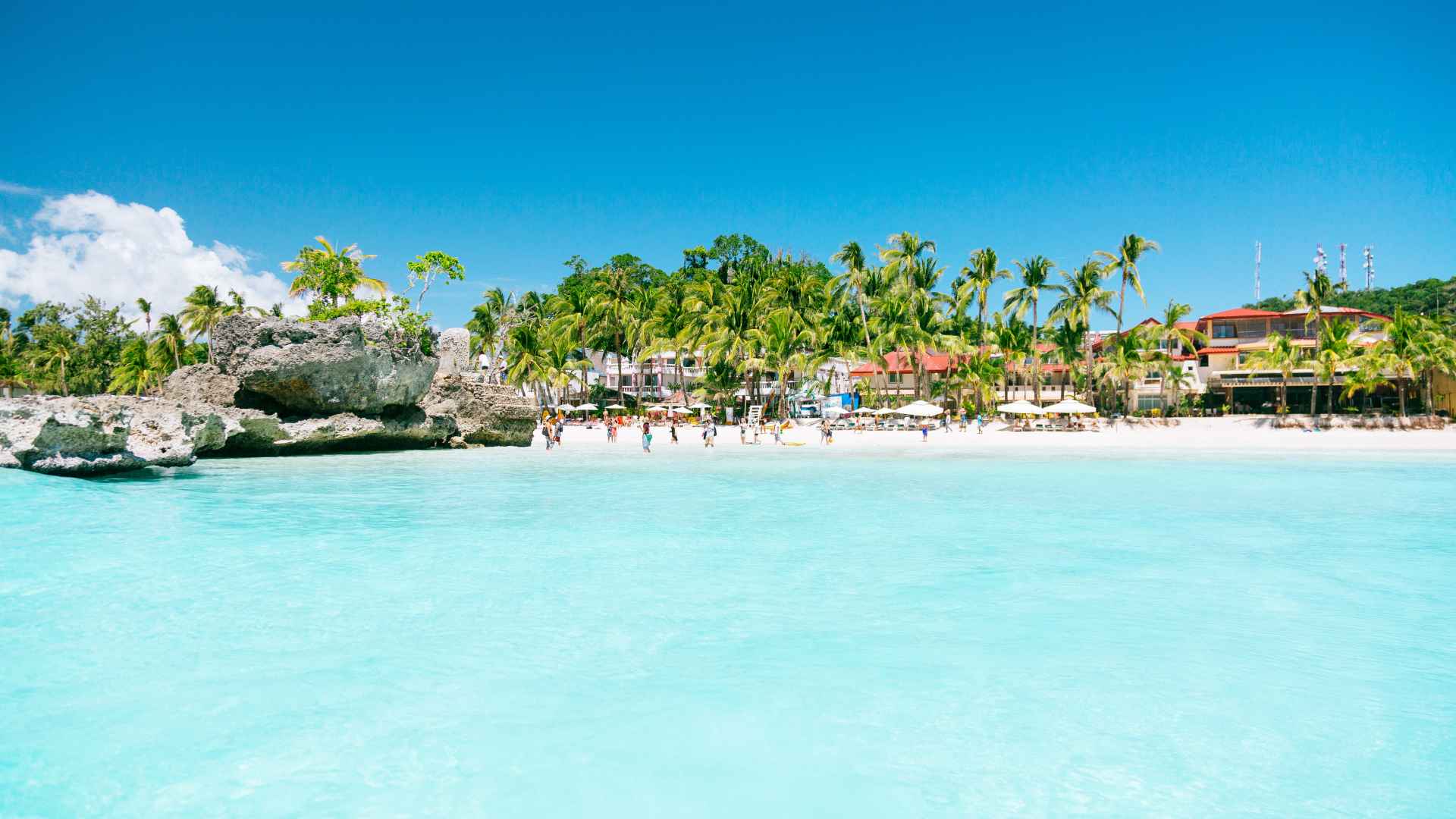
Boracay Island, a jewel in the Philippines, offers an unforgettable blend of natural beauty and vibrant culture:
What is it: An acclaimed island paradise, Boracay is famous for its stunning stretch of white sand beaches, clear blue waters, and a lively atmosphere that caters to tourists looking for both relaxation and entertainment. Its small size is inversely proportional to the vast array of experiences it offers.
Where is it: Situated in the central Philippines, Boracay is part of the Aklan province in the Western Visayas region, easily accessible from major cities both locally and internationally.
Why visit: The island stands out for its incredible natural landscapes, world-class beaches, and its vibrant nightlife. The government’s recent efforts to rehabilitate and preserve its natural beauty have further cemented its status as a top destination for eco-conscious travelers and beach lovers alike.
Top things to do and see in Boracay:
- Water Sports: From kiteboarding to parasailing, the island’s clear waters offer the perfect setting for a variety of water-based activities.
- Sunset Sailing: Experience the breathtaking Boracay sunset from a traditional paraw sailing boat.
- Beach Hopping: Explore the island’s numerous beaches, each offering a different vibe, from the bustling White Beach to the more serene Puka Shell Beach.
- Cultural Festivals: Participate in local celebrations such as the Ati-Atihan Festival, which showcases the island’s rich culture and heritage.
3. Chocolate Hills, Bohol
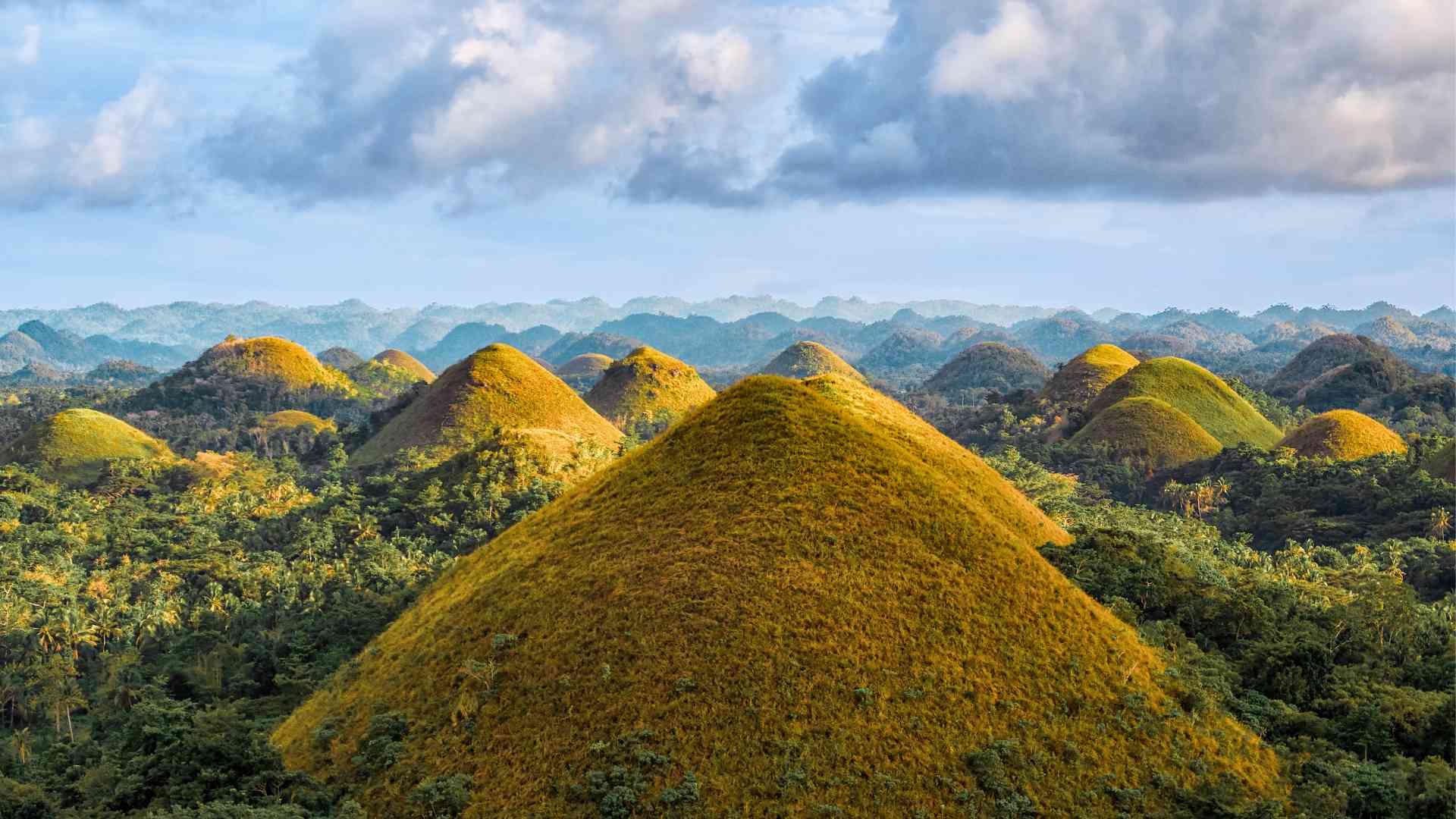
The Chocolate Hills of Bohol are an iconic natural wonder in the Philippines, captivating visitors with their unique landscape:
What is it: An extraordinary geological formation, the Chocolate Hills consist of at least 1,268 hills spread over an area of more than 50 square kilometers. These almost symmetrical and same-sized formations turn brown during the dry season, resembling vast rows of chocolate, hence their name.
Where is it: Located in the province of Bohol, in the Central Visayas region of the Philippines, the Chocolate Hills are easily accessible from the capital city of Tagbilaran.
Why it’s one of the best places to visit in the Philippines: This natural phenomenon is unmatched anywhere else in the country, making it a must-see for its unique aesthetic and the panoramic vistas it offers. The area’s designation as a National Geologic Monument highlights its importance and the commitment to preserving its natural beauty.
Top things to do and see there:
- Viewing Decks: Visit the observation decks at Carmen, Sagbayan, and Chocolate Hills Adventure Park for the best views of the hills.
- Adventure Park: Engage in activities like zip-lining and biking on a rope bridge at the Chocolate Hills Adventure Park.
- Tarsier Conservation Area: Explore the nearby sanctuary to see one of the world’s smallest primates in their natural habitat.
- Loboc River Cruise: Enjoy a scenic and relaxing river cruise, often accompanied by a local buffet meal.
4. Banaue Rice Terraces - Eighth Wonder of the World
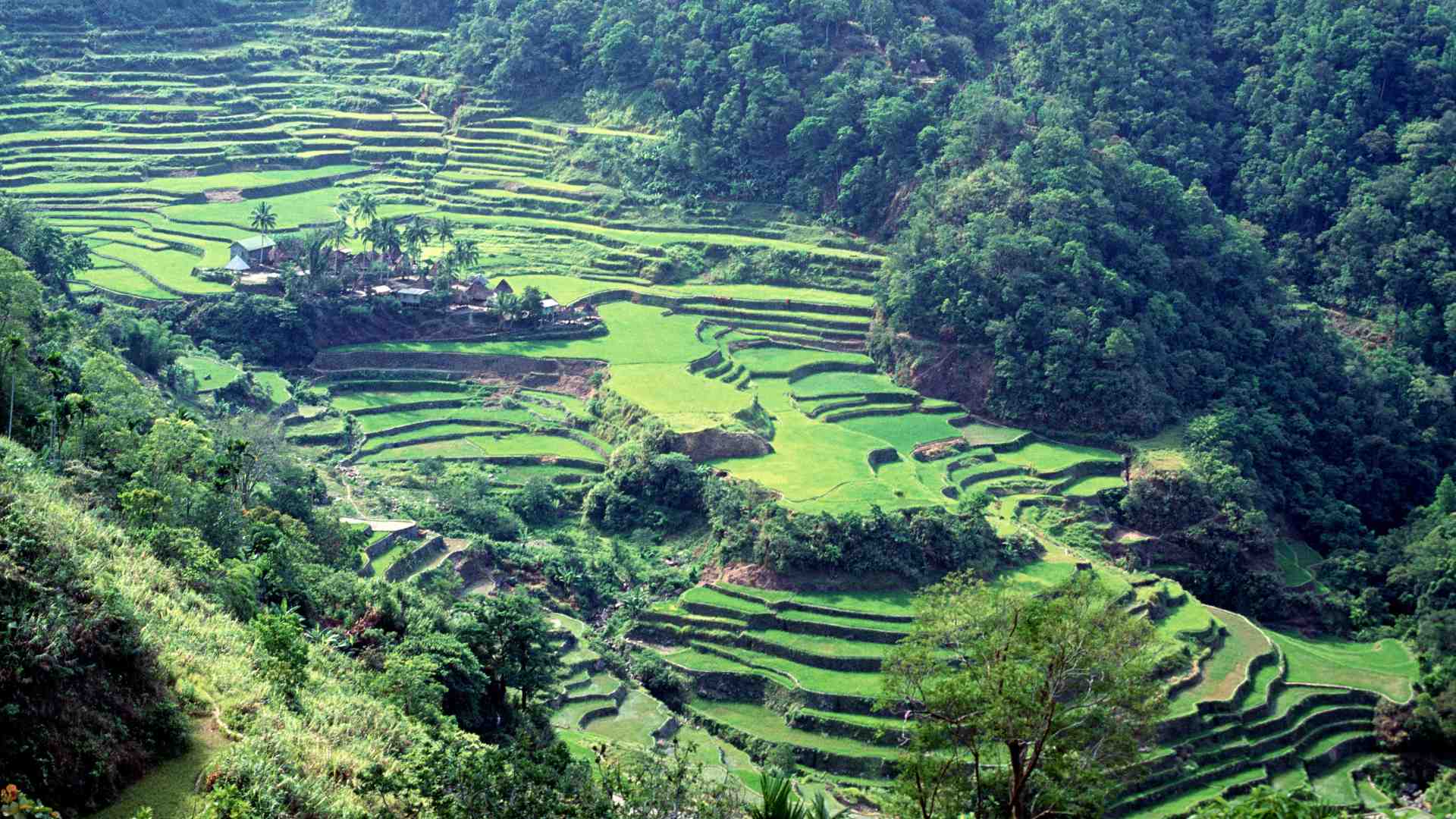
The Banaue Rice Terraces in the Philippines are a testament to ancient ingenuity and cultural heritage:
What is it: Often referred to as the “Eighth Wonder of the World,” the Banaue Rice Terraces are a magnificent network of terraced fields carved into the mountains of Ifugao by the ancestors of the indigenous people over 2,000 years ago. These terraces are a living cultural landscape, illustrating a unique harmony between humans and their environment.
Where is it: Situated in the Cordillera mountain range in Northern Luzon, these terraces are part of the larger cultural landscape in the Ifugao province, which is recognized by UNESCO as a World Heritage Site.
Why visit: The Banaue Rice Terraces represent an unparalleled feat of agricultural engineering and cultural continuity. Their historical significance, combined with the breathtaking natural beauty of the surrounding landscapes, makes them a must-visit destination for those interested in history, culture, and nature.
Top things to do and see there:
- Terrace Viewing Points: Take in the panoramic views from the main viewing deck in Banaue town and other spots such as Batad and Hapao.
- Trekking: Explore the terraces up close through guided treks that range from easy walks to challenging hikes, providing insight into local life and traditions.
- Cultural Interaction: Visit traditional Ifugao villages and immerse yourself in the local culture by learning about the community’s way of life, agricultural practices, and ancestral rituals.
- Tappiyah Waterfall: Take a trek to this stunning waterfall near Batad, a perfect spot for a refreshing swim after a day of exploration.
5. Siargao Island - A surfers' paradise
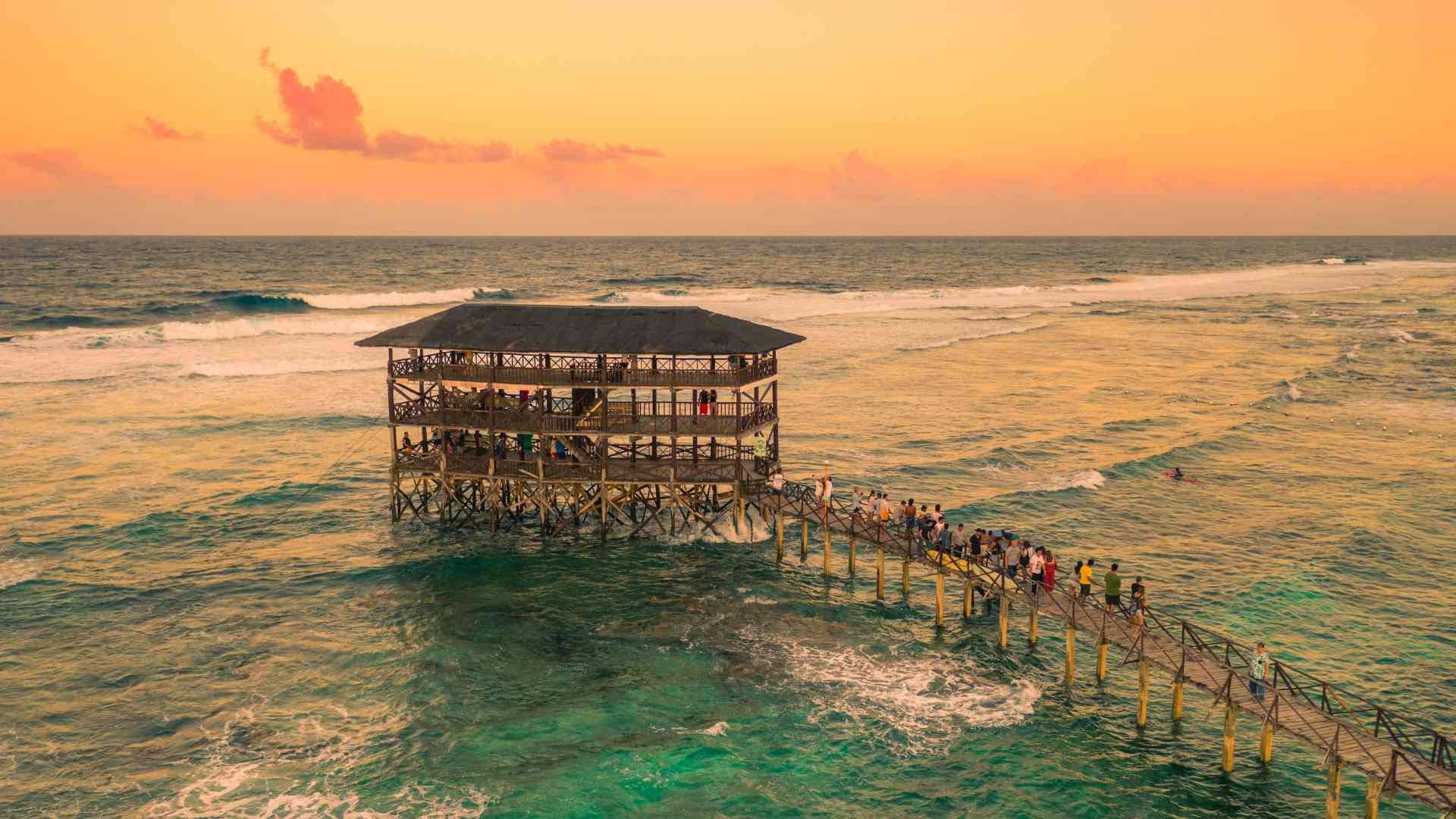
Siargao Island, renowned for its pristine beauty and surfing culture, stands out as a premier destination in the Philippines:
What is it: Siargao is a teardrop-shaped island known as the surfing capital of the Philippines. Beyond its famous waves, the island is celebrated for its unspoiled natural beauty, including white sandy beaches, crystal-clear waters, coconut woodlands, and unique rock formations.
Where is it: Located in the Philippine Sea off the northeastern coast of Mindanao, Siargao is part of the Surigao del Norte province. It’s accessible by air with direct flights from major cities in the Philippines.
Why Siargao Island is one of the best places to visit in the Philippines: Siargao’s laid-back atmosphere, coupled with its natural attractions and vibrant local culture, makes it a haven for adventurers, nature lovers, and those seeking to escape the hustle and bustle of urban life. The island’s dedication to eco-tourism and community-based initiatives also appeals to environmentally conscious travelers.
Top things to do and see there:
- Surfing at Cloud 9: Experience the thrill of surfing at Cloud 9, one of the best surf spots in the world, suitable for both beginners and experienced surfers.
- Island Hopping: Explore nearby islands like Daku, Guyam, and Naked Island, each offering unique landscapes and activities.
- Magpupungko Rock Pools: Visit these natural tidal pools during low tide for a unique swimming experience.
- Sohoton Cove National Park: Embark on a boat tour to this protected area known for its lagoons, caves, and jellyfish sanctuary.
6. Intramuros, Manila - A historic walled area
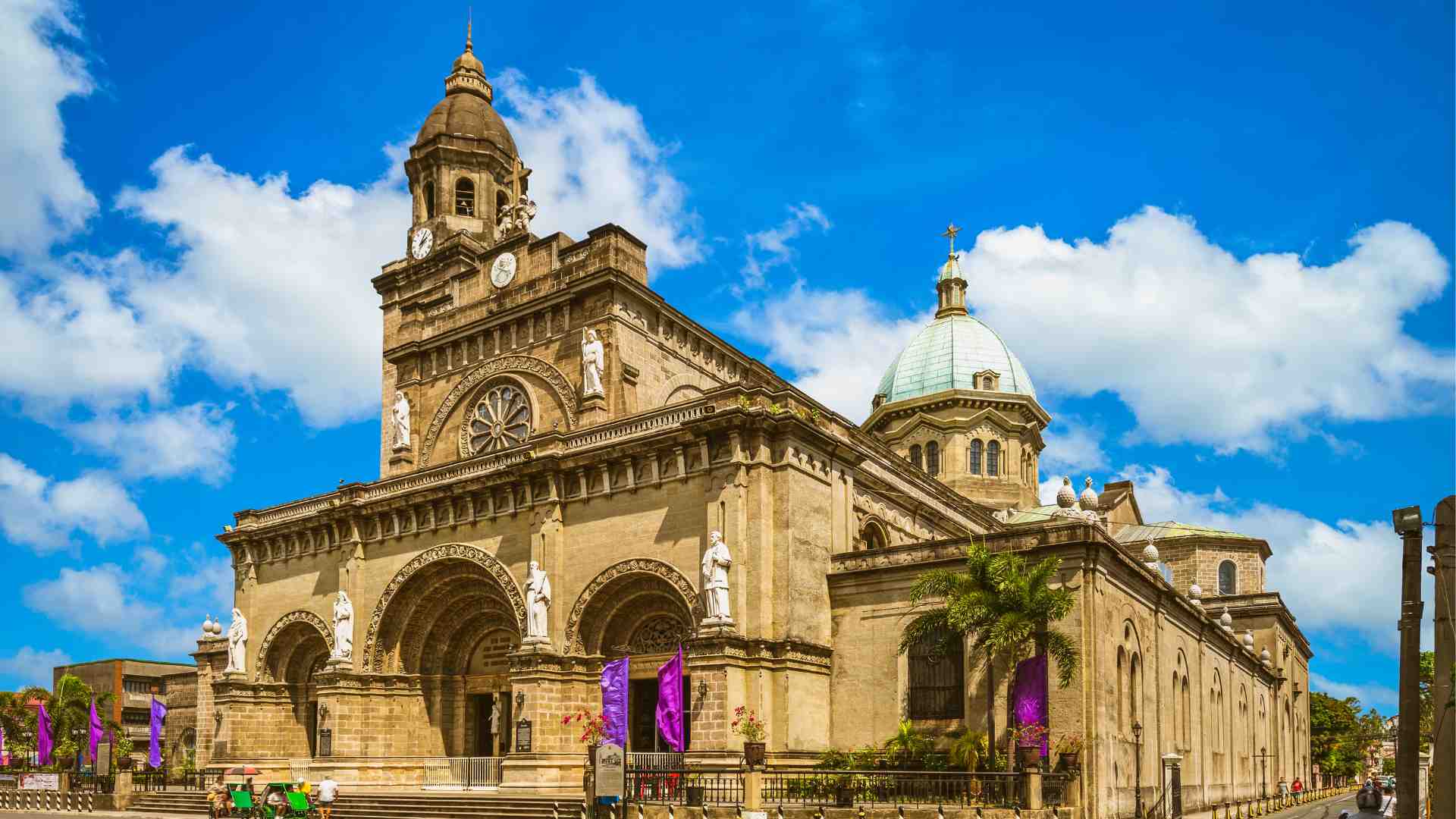
Intramuros, known as the Walled City, is a rich historical and cultural enclave in the heart of Manila, Philippines:
What is it: Intramuros is the oldest district and historic core of Manila, reflecting the city’s colonial past. This fortified area was built by the Spanish in the late 16th century, featuring ancient walls, churches, museums, and ruins, offering a glimpse into the Philippines’ Spanish colonial era.
Where is it: Situated on the banks of the Pasig River in the capital city of Manila, Intramuros is easily accessible from any part of the city, making it a central point of interest for visitors and locals alike.
Why visit: Intramuros stands out as a testament to Philippine history, architecture, and resilience. It offers an immersive experience into the country’s colonial history, showcasing well-preserved structures and providing educational insights through its museums and historic sites. The district’s efforts to preserve and promote Philippine heritage attract history buffs, culture enthusiasts, and anyone looking to understand the country’s past.
Top things to do and see there:
- Fort Santiago: Explore this key historical military fort that played a significant role in the Philippines’ history.
- San Agustin Church and Museum: Visit the oldest stone church in the Philippines, a UNESCO World Heritage site, with its stunning architecture and religious artifacts.
- Casa Manila: Experience a taste of colonial lifestyle in this museum replicating a 19th-century Spanish colonial house.
- Walking Tours: Join a guided walking tour to learn about the rich history of Intramuros, including visits to hidden tunnels and historic sites not commonly known to the public.
7. Taal Volcano and Lake, Batangas
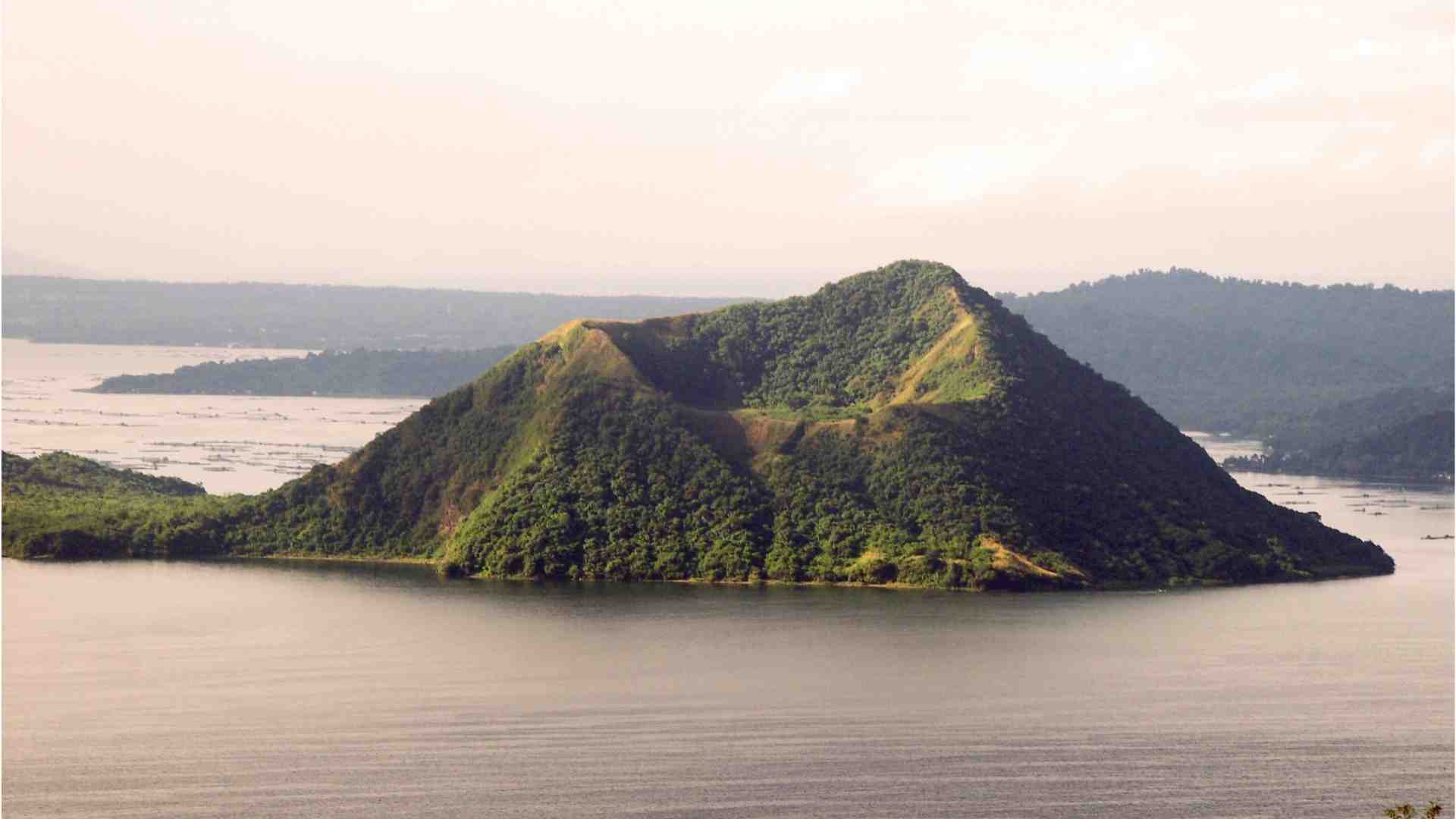
Taal Volcano and Lake offer a unique natural attraction in the Philippines, known for its picturesque beauty and thrilling activities:
What is it: Taal Volcano, one of the world’s smallest active volcanoes, is set within Taal Lake on Luzon Island. This geological wonder features a crater lake on its volcano island, which also contains another small islet, Vulcan Point.
Where is it: Located in the province of Batangas, just about 50 kilometers south of Manila, Taal Volcano and Lake are easily accessible for both day trips and longer stays from the capital.
Why it’s one of the best places to visit in the Philippines: The site offers a rare opportunity to see a volcano within a lake on an island within a lake on an island, providing a unique geological phenomenon. The scenic beauty of Taal Volcano and Lake, combined with the adventure it offers, makes it a popular destination for both local and international tourists. Its proximity to Manila also adds to its appeal, making it an easy escape to nature from the urban environment.
Top things to do and see there:
- Volcano Trekking: Embark on a guided hike to the crater of Taal Volcano for a close-up view of the crater lake.
- Boat Tour on Taal Lake: Enjoy a boat ride on Taal Lake, offering stunning views of the volcano and surrounding landscapes.
- Horseback Riding: Opt for a horseback ride up the volcano, an alternative and exciting way to reach the crater.
- Picnic by the Lake: The areas surrounding Taal Lake provide perfect spots for a scenic picnic with views of the volcano.
8. Puerto Princesa Subterranean River National Park
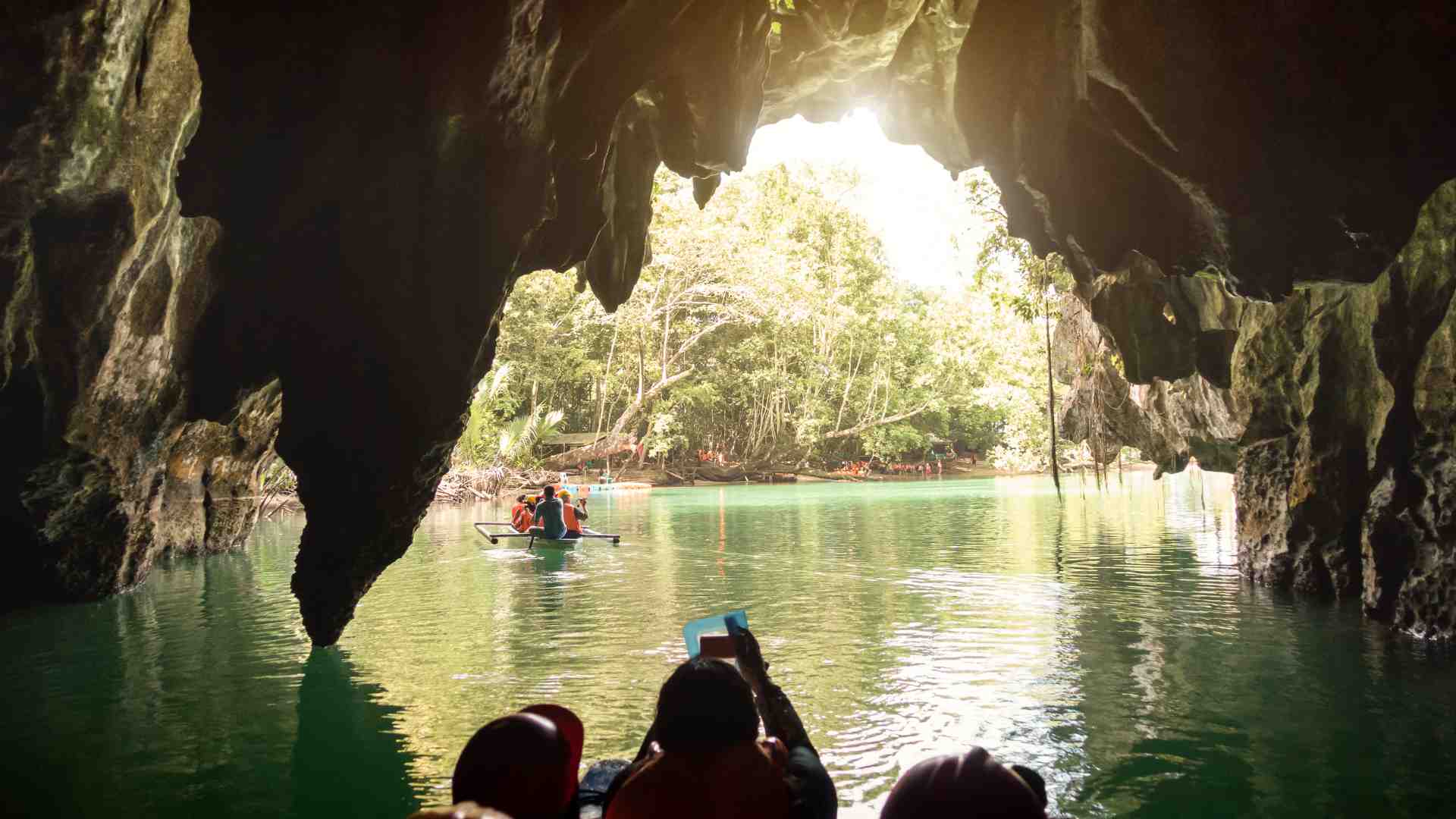
The Puerto Princesa Subterranean River National Park is a remarkable natural wonder and UNESCO World Heritage Site in the Philippines:
What is it: This park is home to one of the most impressive cave systems in the world, featuring a navigable underground river that flows directly into the sea. The cave’s karst limestone landscape and complex ecosystem make it a significant natural site.
Where is it: Located on the mid-western coast of Palawan Island, the park is easily accessible from the city of Puerto Princesa, serving as a major tourist attraction in the region.
Why it’s one of the best places to visit in the Philippines: The subterranean river is renowned for its ecological and geological significance, offering visitors a unique adventure through its spectacular cave formations and diverse wildlife. Its recognition as a UNESCO site underscores its global importance as a natural treasure.
Top things to do and see:
- Underground River Tour: Experience a guided boat tour through the dark, echoing chambers of the underground river, marveling at the stalactites and stalagmites.
- Eco-Tourism Activities: Engage in eco-friendly activities within the park, such as bird watching, trekking, and mangrove paddle boating, to explore its rich biodiversity.
- Zip Lining: For the more adventurous, several zip-line courses offer breathtaking views over the forest canopy and limestone cliffs.
- Beach Relaxation: Take some time to relax on the pristine beaches near the park, enjoying the sun and sea in a tranquil natural setting.
9. Vigan City, Ilocos Sur
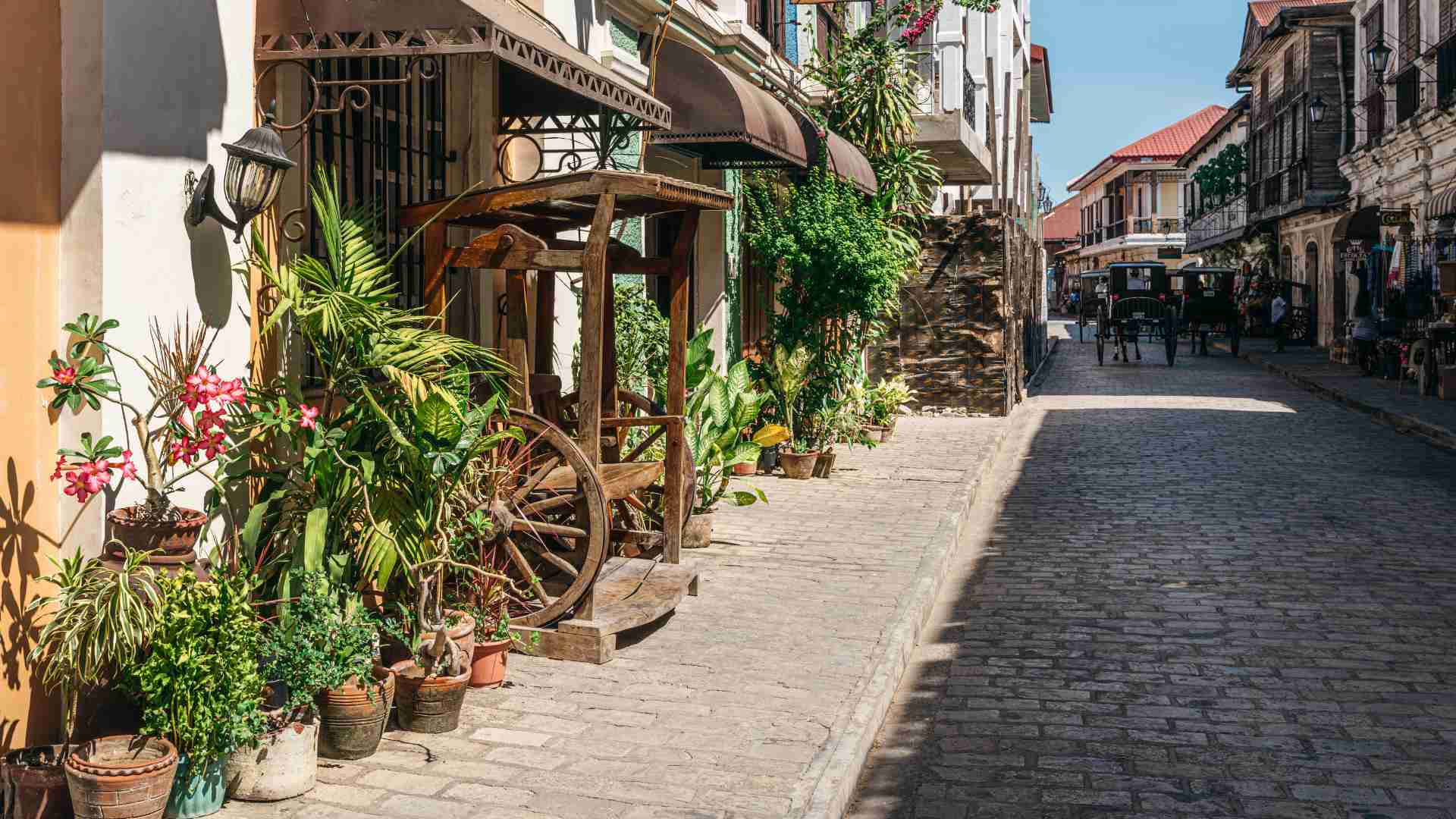
Vigan City, located in the province of Ilocos Sur, is a unique destination in the Philippines, known for its well-preserved Spanish colonial and Asian architecture:
What is it: Vigan is a UNESCO World Heritage Site and one of the few remaining Spanish colonial towns in the Philippines. The city’s historic center, characterized by cobblestone streets and colonial-era houses, offers a glimpse into the Philippines’ colonial past.
Where is it: Situated on the western coast of the island of Luzon, Vigan is the capital of Ilocos Sur province. It’s accessible by land from Manila and other parts of Luzon.
Why visit: Vigan stands out for its historical significance and architectural beauty, offering an immersive experience into the Spanish colonial era. Its preservation efforts have earned it recognition as a UNESCO World Heritage Site, attracting those interested in history, culture, and architecture.
Top things to do and see there:
- Calle Crisologo: Walk through this iconic street lined with Spanish-style houses, antique shops, and quaint cafés.
- Syquia Mansion Museum: Explore this 19th-century mansion for a deeper understanding of Filipino-Spanish aristocratic life.
- Kalesa Ride: Experience a traditional horse-drawn carriage ride around the city, visiting historic sites and local markets.
- Pottery Making: Visit a local pottery workshop to observe traditional pottery making techniques and try your hand at creating your own piece.
10. Mount Pulag - The third highest mountain in the Philippines
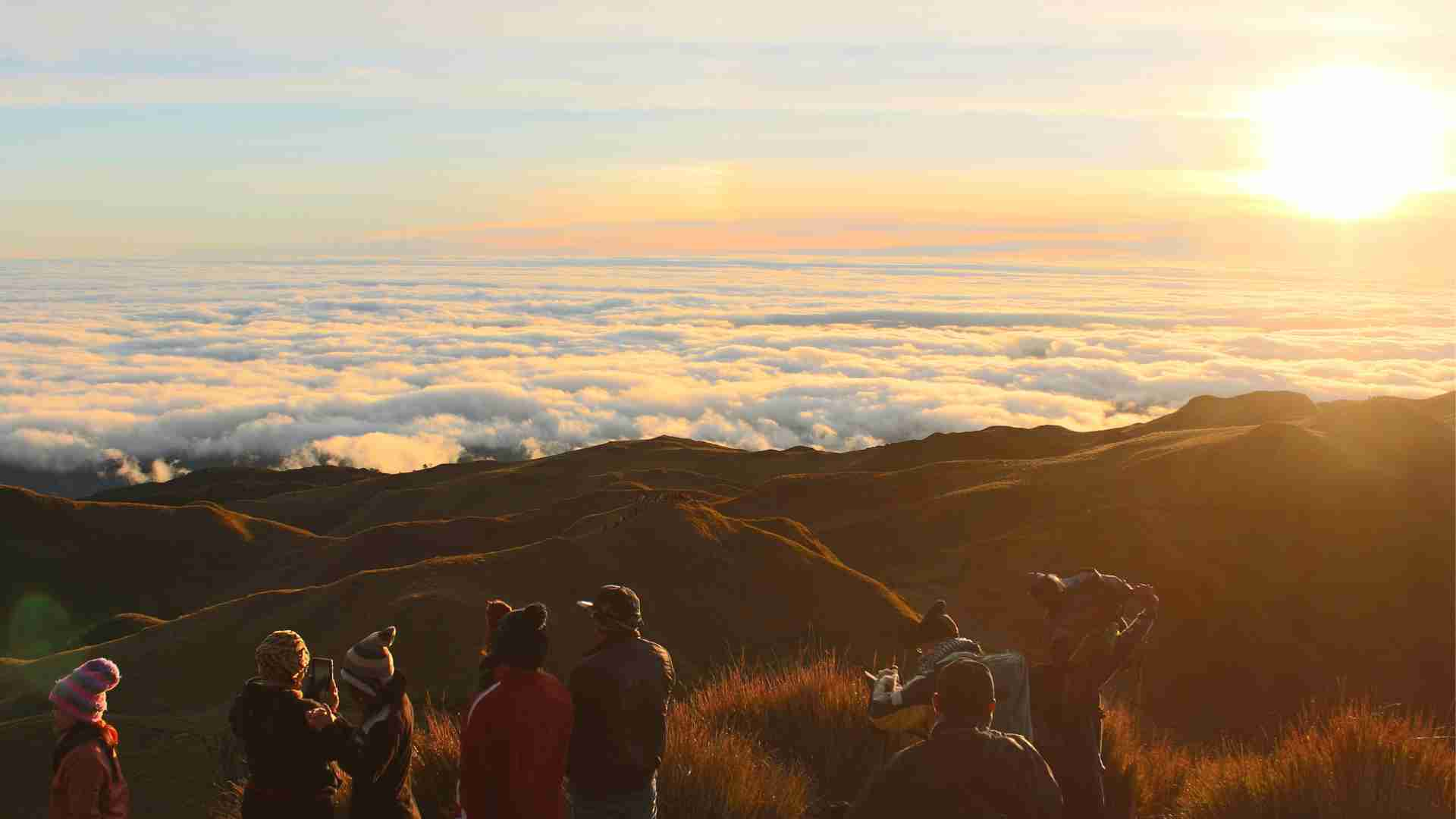
Mount Pulag is one of the Philippines’ most famous mountains and a dream destination for many hikers and nature enthusiasts:
What is it: Mount Pulag is the third highest mountain in the Philippines, known for its majestic sea of clouds and its diverse ecosystems, including pine forests, mossy forests, and grasslands. It’s a key biodiversity area, home to many endemic species of flora and fauna.
Where is it: Located on the island of Luzon, Mount Pulag straddles the boundaries of Benguet, Ifugao, and Nueva Vizcaya provinces. It’s accessible from Baguio City, which serves as the jumping-off point for most climbers.
Why it’s one of the best places to visit in the Philippines: The mountain is famed for its breathtaking landscapes, particularly the sea of clouds phenomenon at sunrise, which attracts hikers from around the world. Its unique biodiversity and the cultural experiences offered by the local indigenous communities make it a compelling destination for eco-tourists and those interested in cultural immersion.
Top things to do and see there:
- Hiking: Tackle the challenging yet rewarding trek to the summit, which offers stunning views and the chance to walk above the clouds.
- Camping: Spend a night on the mountain to experience the incredible starry skies and catch the sunrise over the sea of clouds.
- Bird Watching: The mountain’s diverse ecosystems are a haven for bird watchers, with numerous endemic species to be spotted.
- Cultural Interaction: Engage with the local communities living on the mountain’s slopes to learn about their traditions and way of life.
11. Oslob, Cebu - Famous for whale shark watching
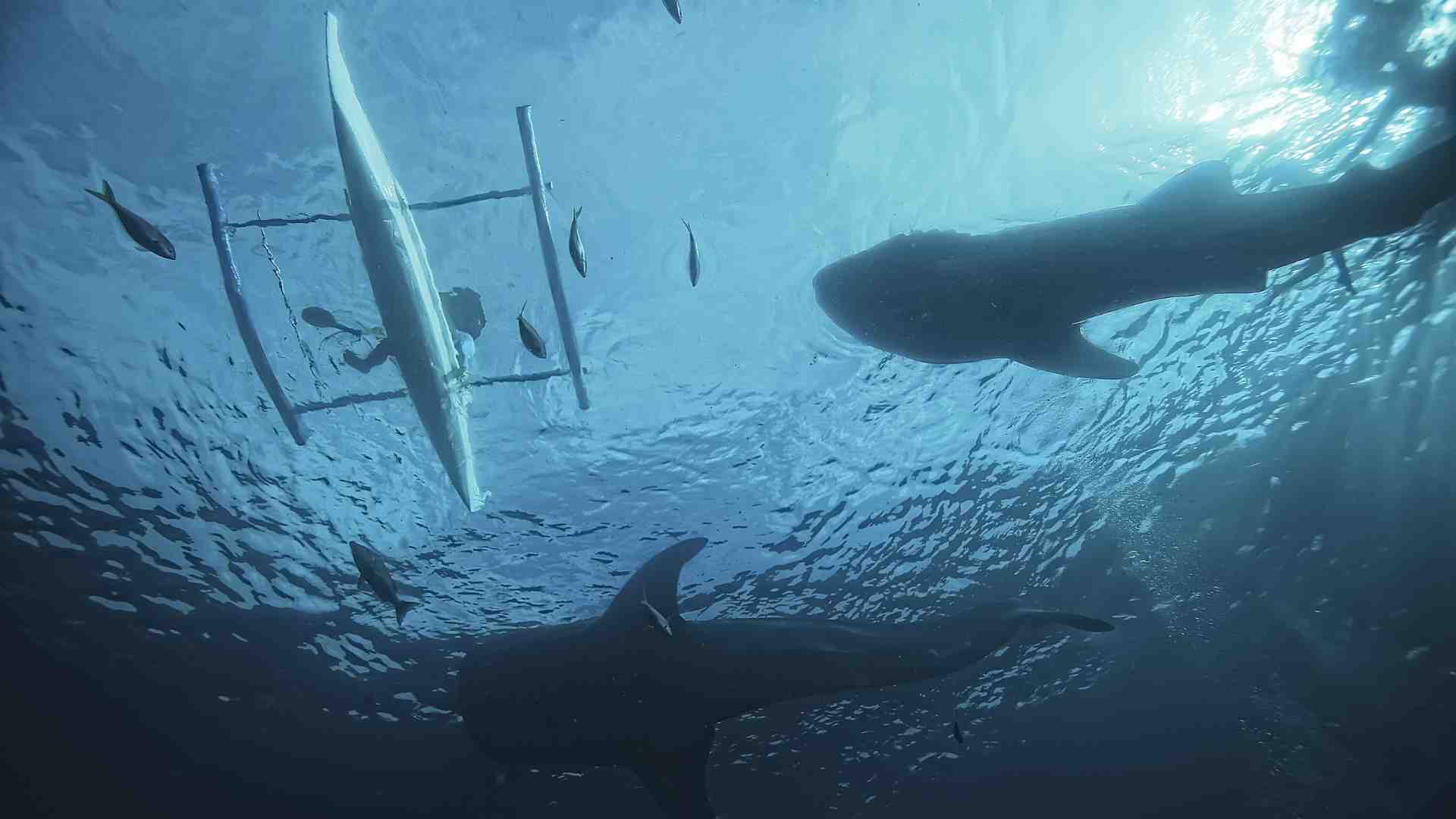
Oslob, located in the province of Cebu, has become one of the Philippines’ most visited destinations due to its unique marine attractions:
What is it: Oslob is best known for its whale shark watching activities, where visitors can swim close to these gentle giants in their natural habitat. This small town has gained international attention for offering one of the most accessible ways to interact with whale sharks.
Where is it: Situated on the southeastern coast of Cebu Island, Oslob is approximately 120 kilometers from Cebu City, making it a popular day-trip destination for tourists staying in the city.
Why visit: The opportunity to swim with whale sharks in Oslob offers a unique wildlife interaction that’s hard to find anywhere else. The town’s commitment to regulated interactions ensures the safety of both the animals and the visitors, making it a responsible eco-tourism spot.
Top things to do and see there:
- Whale Shark Watching: Experience swimming or snorkeling with whale sharks in a regulated environment for an unforgettable encounter.
- Tumalog Falls: Visit this nearby stunning waterfall for a refreshing dip in its cool, clear waters.
- Sumilon Island: Take a boat trip to this beautiful island nearby, known for its pristine white sand beaches and excellent snorkeling spots.
- Heritage Sites: Explore Oslob’s rich history through its preserved colonial structures, including the Our Lady of the Immaculate Conception Church and the Cuartel ruins.
12. Sagada - hanging coffins and serene landscapes
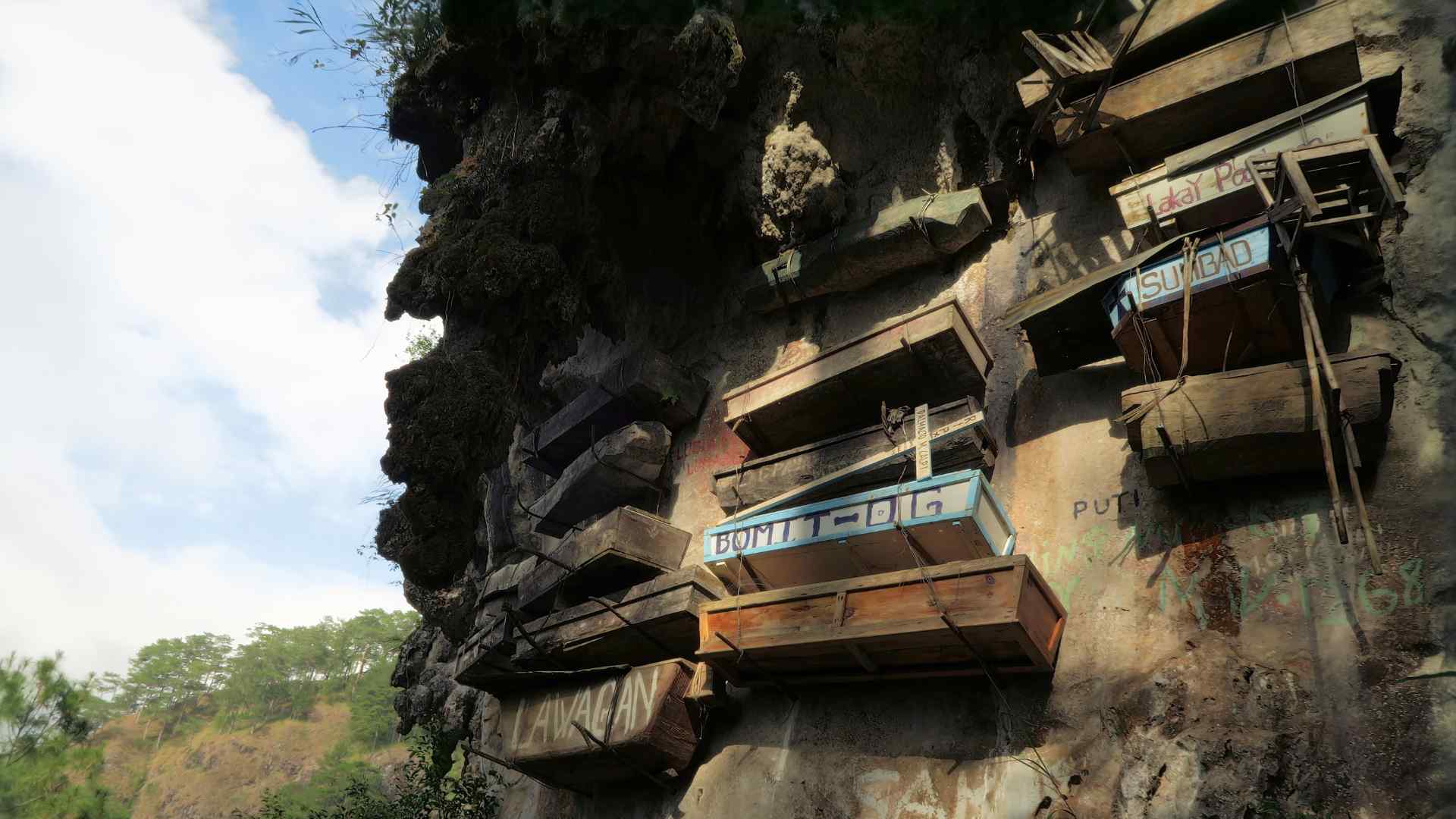
Sagada, nestled in the Mountain Province of the Philippines, is a serene town famous for its rugged landscapes, rich culture, and adventurous activities:
What is it: Sagada is renowned for its unique burial traditions, such as the hanging coffins, and its extensive cave systems. The town is a haven for those seeking tranquility, adventure, and a deeper understanding of indigenous cultures.
Where is it: Located high in the Cordillera Mountains of Northern Luzon, Sagada offers a cool climate and breathtaking views of pine forests and terraced valleys. It’s a remote destination, providing a peaceful retreat from the bustling city life.
Why visit: Sagada’s blend of natural beauty, cultural depth, and adventure opportunities make it a standout destination. It’s a place where visitors can connect with nature, explore ancient traditions, and challenge themselves with outdoor activities, all within a community known for its hospitality and sustainable tourism practices.
Top things to do and see there:
- Explore the Caves: Venture into the Sumaguing and Lumiang Caves for spelunking adventures that reveal stunning rock formations and ancient burial sites.
- See the Hanging Coffins: Witness this traditional Igorot burial practice at Echo Valley, where coffins are suspended from cliffs.
- Trek to Bomod-Ok Falls: Hike through rice terraces to reach this impressive waterfall, perfect for cooling off after a long walk.
- Watch the Sunrise at Kiltepan Peak: Experience the breathtaking view of the sun rising over a sea of clouds, with the terraces below.
13. Camiguin Island
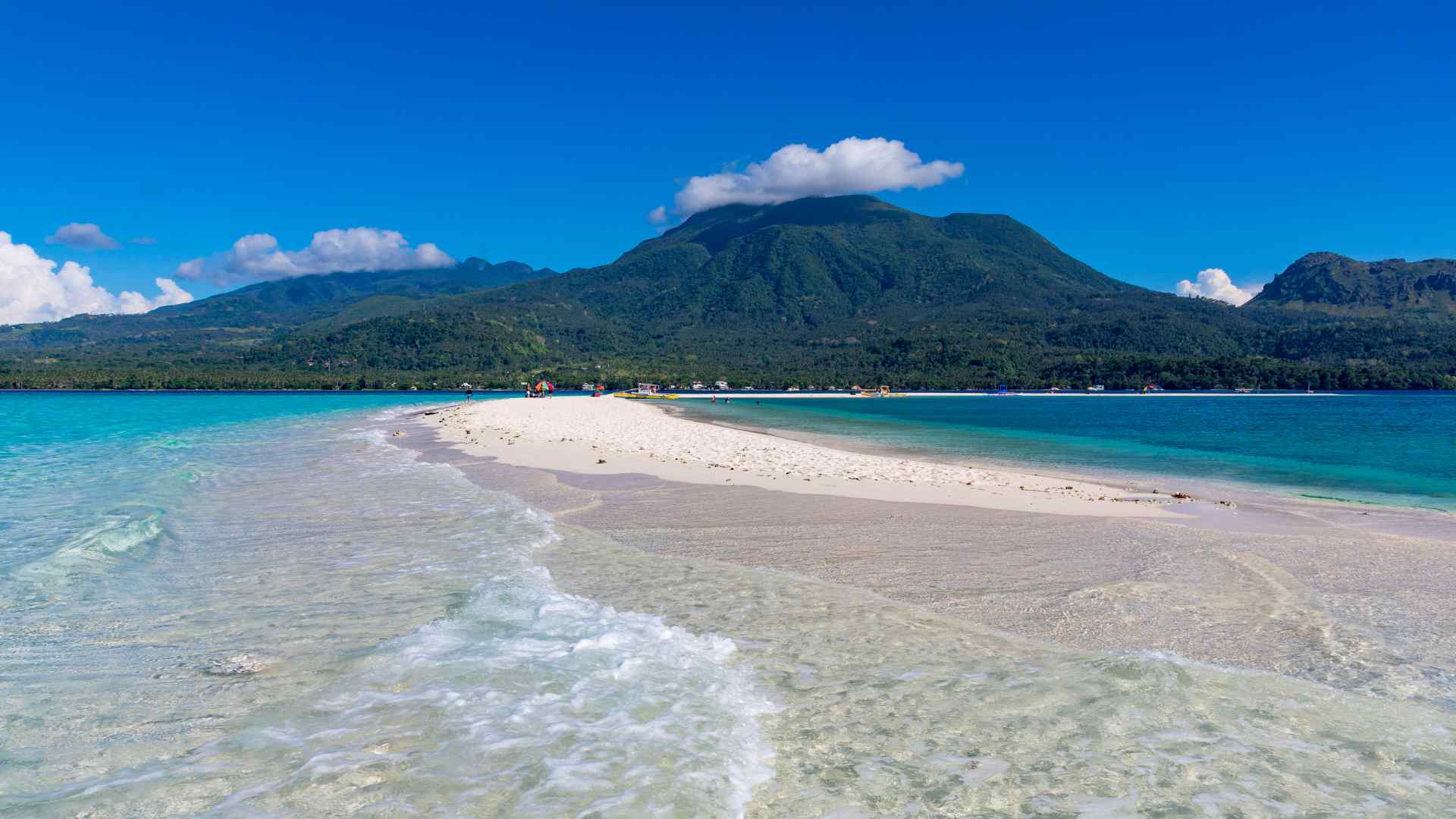
Camiguin Island is a spectacular destination in the Philippines, celebrated for its volcanic landscapes, pristine beaches, and hot springs:
What is it: Known as the “Island Born of Fire,” Camiguin boasts several active and dormant volcanoes, lush rainforests, stunning waterfalls, and a rich diversity of marine life. Its compact size belies the abundance of natural attractions and activities available to visitors.
Where is it: Located in the Bohol Sea, off the northern coast of Mindanao, Camiguin is easily accessible by ferry from neighboring islands and cities. Its remote location contributes to its unspoiled beauty and tranquil atmosphere.
Why it’s one of the best places to visit in the Philippines: Camiguin’s unique volcanic topography offers a variety of natural attractions, from hot springs and cold springs to underwater cemeteries and sunken volcanoes, making it a paradise for nature lovers and adventure seekers. The island’s commitment to preserving its natural environment ensures an eco-friendly visitor experience.
Top things to do and see there:
- Sunken Cemetery: Dive or snorkel in this unique underwater site, marked by a large cross standing in the sea.
- Ardent Hot Springs: Relax in these natural hot springs nestled at the foot of Hibok-Hibok Volcano.
- White Island: Visit this stunning, uninhabited white sandbar for breathtaking views of Camiguin’s volcanoes and crystal-clear waters.
- Katibawasan Falls: Marvel at this towering waterfall set in a lush forest, offering a refreshing swim in its cool pool.
14. Rizal Park, Manila
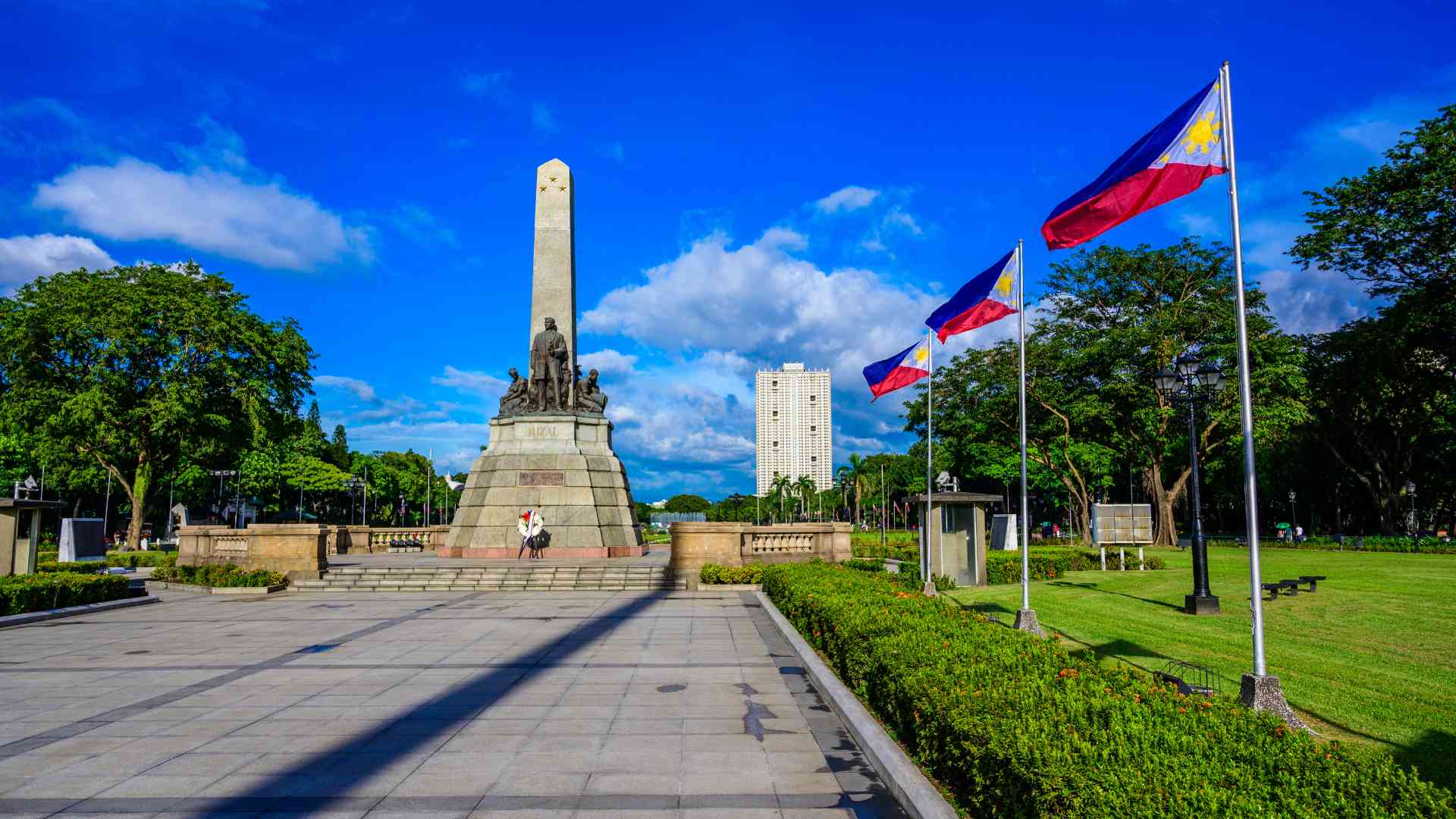
Rizal Park, also known as Luneta Park, is a historic urban park located in the heart of Manila, Philippines, and serves as a significant symbol of Filipino independence and heroism:
What is it: Rizal Park is a sprawling urban oasis that honors Dr. Jose Rizal, the national hero of the Philippines. The park is a focal point for historical, cultural, and leisure activities, featuring gardens, monuments, museums, and an open-air concert hall.
Where is it: Situated in the city of Manila, the park is easily accessible and serves as a green lung in the densely populated capital. It lies adjacent to the walled city of Intramuros and is a stone’s throw away from Manila Bay.
Why visit: Rizal Park is not just a place of leisure but a site of profound historical significance. It’s where Dr. Jose Rizal was executed, sparking the Philippine revolution against Spanish colonial rule. Today, the park offers a peaceful retreat from the hustle and bustle of city life and provides educational insights into the country’s history.
Top things to do and see there:
- Rizal Monument: Pay respects at the monument of Dr. Jose Rizal, which is also the park’s centerpiece.
- National Museum Complex: Explore the nearby museums that house the nation’s premier art, historical, and cultural collections.
- Japanese and Chinese Gardens: Enjoy the serene landscapes of these beautifully designed gardens within the park.
- Light and Sound Show: Experience the history of the Philippines through a captivating light and sound presentation held in the park.
15. Coron Island, Palawan
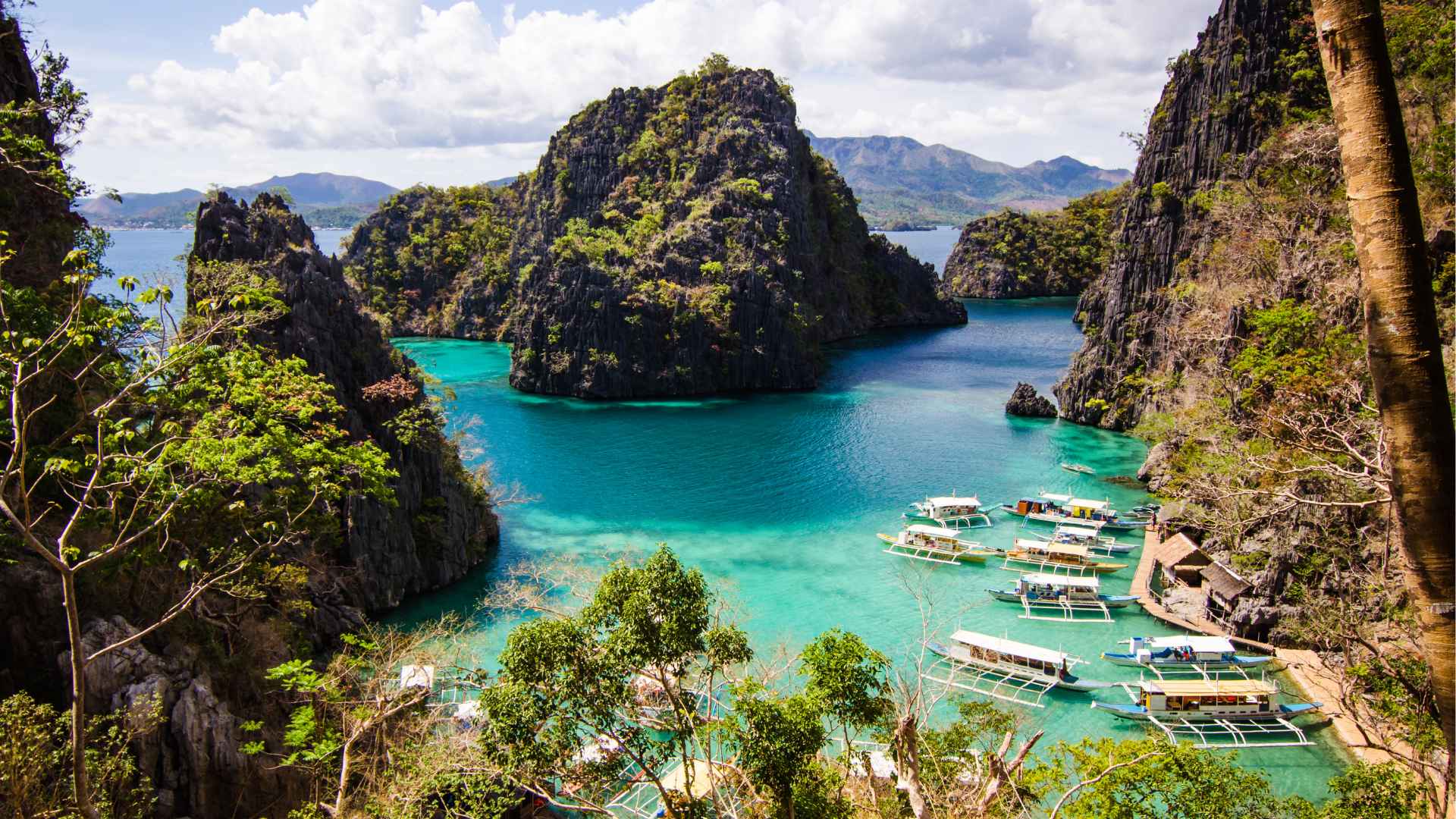
Coron Island, part of the Calamian Islands in Palawan, Philippines, is renowned for its world-class wreck diving, stunning limestone cliffs, and crystal-clear freshwater lakes:
What is it: Coron is a breathtaking island known for its dramatic karst landscapes, underwater shipwrecks from World War II, and pristine natural beauty. It’s a paradise for divers, adventurers, and nature lovers alike.
Where is it: Situated in the northern part of Palawan province, Coron is accessible by boat from Palawan’s capital, Puerto Princesa, and by plane from major cities in the Philippines.
Why it’s one of the best places to visit in the Philippines: The island’s unique combination of historical intrigue, natural wonders, and vibrant marine life makes it a standout destination. Coron offers an exceptional opportunity to explore intact wartime shipwrecks, vibrant coral reefs, and secluded lagoons, all within an ecologically preserved environment.
Top things to do and see there:
- Wreck Diving: Dive among the Japanese shipwrecks from World War II, now home to an abundance of marine life.
- Kayangan Lake: Swim in the crystal-clear waters of one of the cleanest lakes in Asia, surrounded by towering limestone cliffs.
- Twin Lagoons: Explore these unique lagoons, where fresh and salt water mix, creating a unique swimming experience.
- Maquinit Hot Springs: Unwind in one of the few saltwater hot springs in the world, offering therapeutic and relaxing views of the sea.
16. Batanes
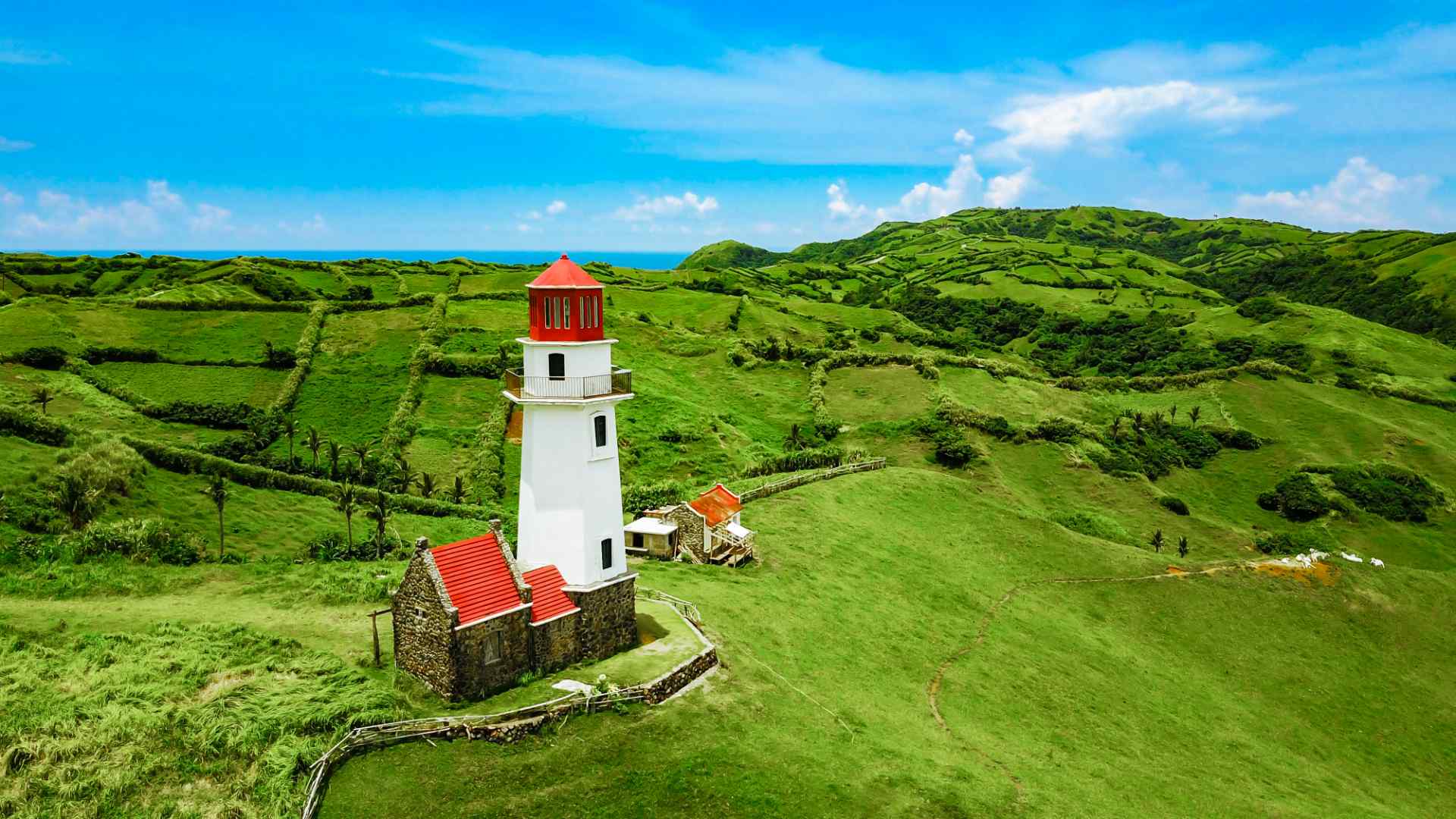
Batanes, the northernmost province of the Philippines, is a breathtaking destination known for its rugged terrain, traditional stone houses, and the warm hospitality of its people, the Ivatans:
What is it: Batanes is a group of islands marked by rolling hills, dramatic cliffs, and deep blue waters. Its landscapes are often compared to those of New Zealand and Scotland, yet it possesses a distinct culture and history that are uniquely its own.
Where is it: Located at the northern tip of the Philippines, Batanes is isolated from the mainland, lying between the South China Sea and the Pacific Ocean. It’s accessible by plane from Manila and other parts of the country.
Why it’s one of the best places to visit in the Philippines: The sheer natural beauty and serene atmosphere of Batanes make it a perfect retreat for those looking to escape the hustle and bustle of city life. The province is also known for its well-preserved culture and traditions, sustainable lifestyle, and the resilience and friendliness of its people.
Top things to do and see there:
- Marlboro Country (Racuh A Payaman): Enjoy panoramic views of rolling hills and the ocean, perfect for photography and relaxation.
- Basco Lighthouse and Naidi Hills: Visit the iconic lighthouse for stunning sunset views and a glimpse of Basco town.
- Stone Houses of Ivana and Savidug: Explore the traditional Ivatan stone houses, known for their thick walls and thatched roofs, designed to withstand typhoons.
- Dipnaysupuan Japanese Tunnel: Discover this World War II tunnel, which offers insights into the island’s history during the Japanese occupation.
17. Mayon Volcano
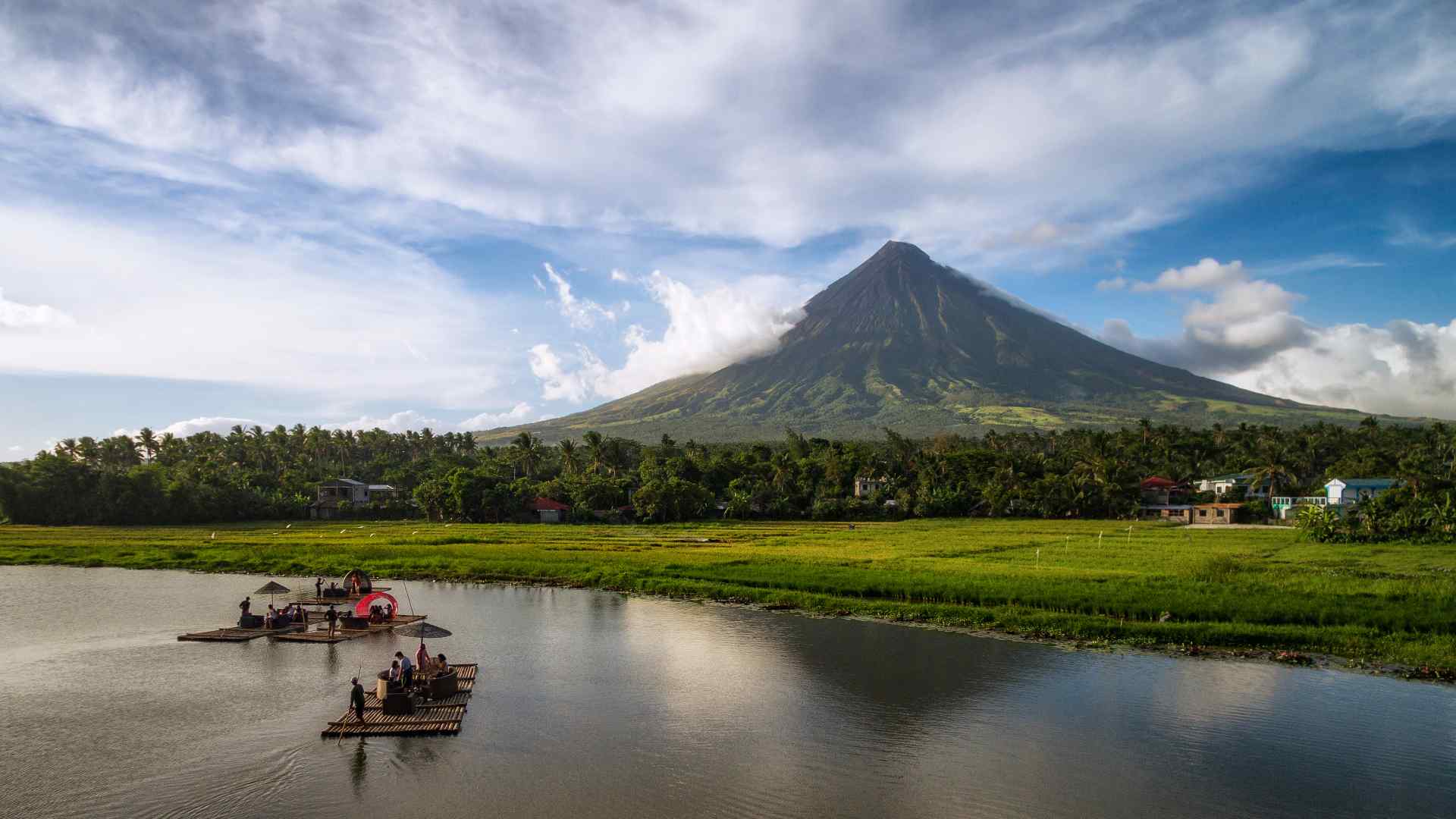
Mayon Volcano, located in the province of Albay in the Bicol Region, stands as one of the Philippines’ most iconic natural landmarks due to its perfect cone shape:
What is it: Mayon Volcano is an active stratovolcano known for its symmetrical cone, often cited as the “world’s most perfect volcanic cone.” It offers a striking backdrop to the province of Albay and is a focal point for both scientific study and tourism.
Where is it: Positioned about 10 kilometers from Legazpi City, the capital of Albay, Mayon Volcano is easily accessible and visible from many points in the region, making it a constant and majestic presence in the daily lives of the local population.
Why visit: Mayon’s perfect cone and active nature make it a unique attraction for tourists. The volcano and its surrounding landscapes offer a variety of outdoor activities, from hiking and ATV tours to aerial tours for the more adventurous. The area around Mayon Volcano is also rich in cultural and historical sites, providing a well-rounded experience for visitors.
Top things to do and see there:
- ATV Adventure Tours: Navigate through lava flows and rugged terrain at the base of Mayon Volcano for an adrenaline-pumping experience.
- Cagsawa Ruins: Visit the remains of a 16th-century church that was buried by the 1814 eruption, offering a haunting reminder of Mayon’s power and a popular spot for photography.
- Lignon Hill: Enjoy panoramic views of Mayon Volcano and Legazpi City from this viewpoint, which also offers zip-lining and other recreational activities.
- Daraga Church: Explore this baroque-style church known for its intricate façade and as a vantage point for viewing Mayon.
Conclusion
From the stunning beaches of Boracay to the majestic Mayon Volcano, each site provides a unique glimpse into the country’s diverse beauty. Whether it’s the serene tranquility of Batanes, the historical echoes of Intramuros, or the underwater marvels of Coron Island, the Philippines caters to every type of traveler. As we’ve explored these 17 best places to visit, it’s clear that the Philippines is not just a destination but a journey through breathtaking landscapes, vibrant cultures, and experiences that linger long after the journey ends.

